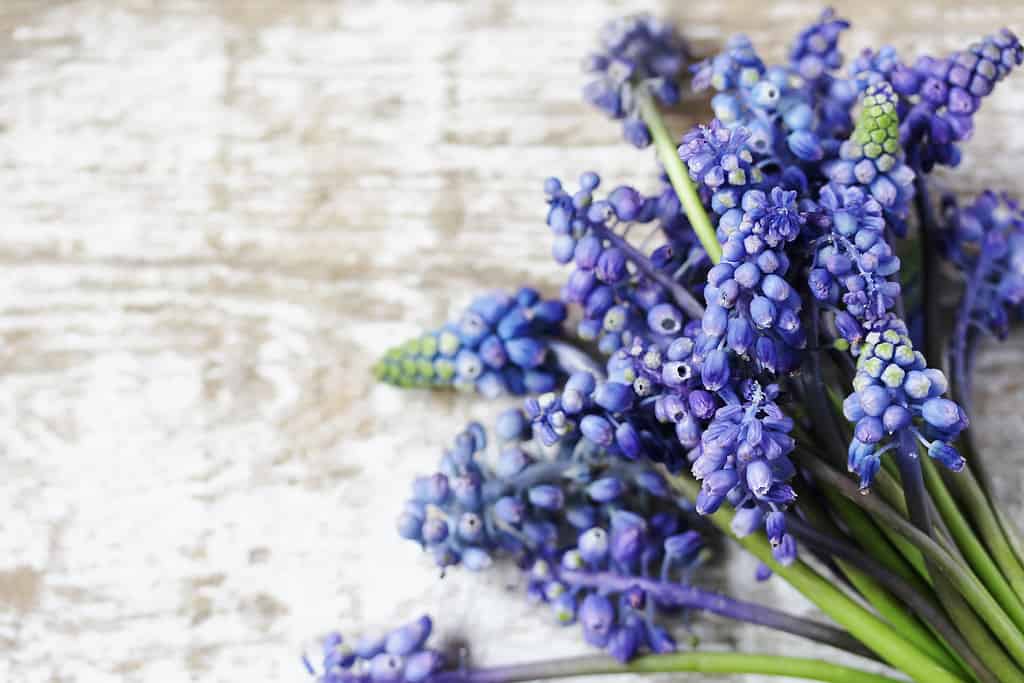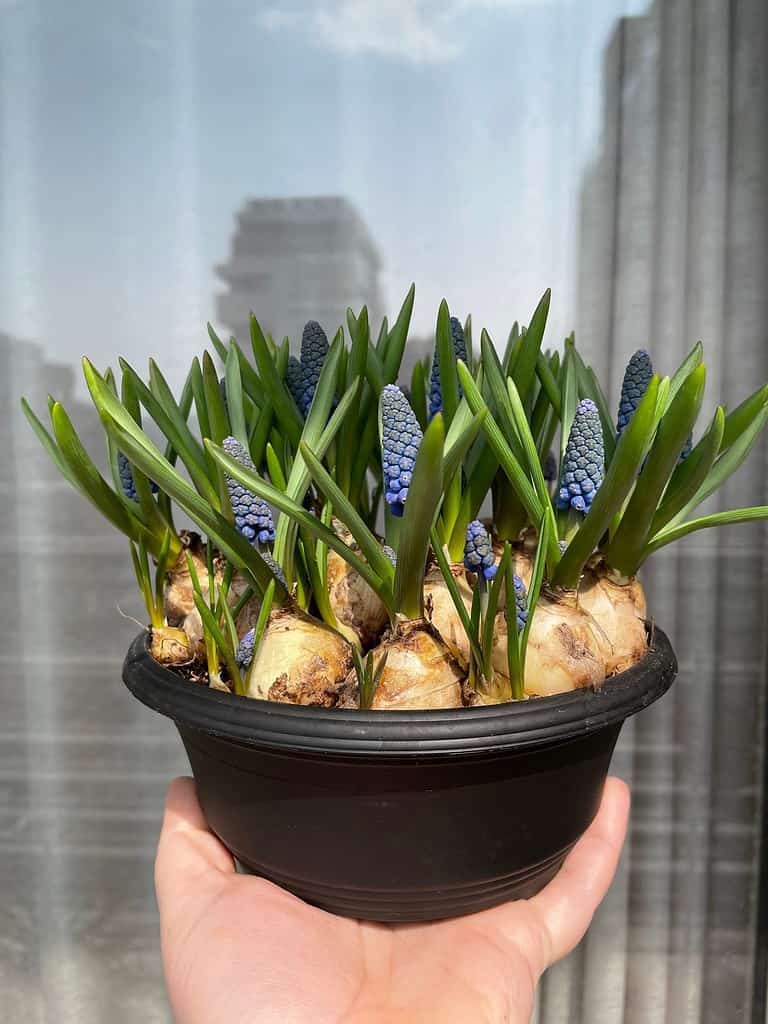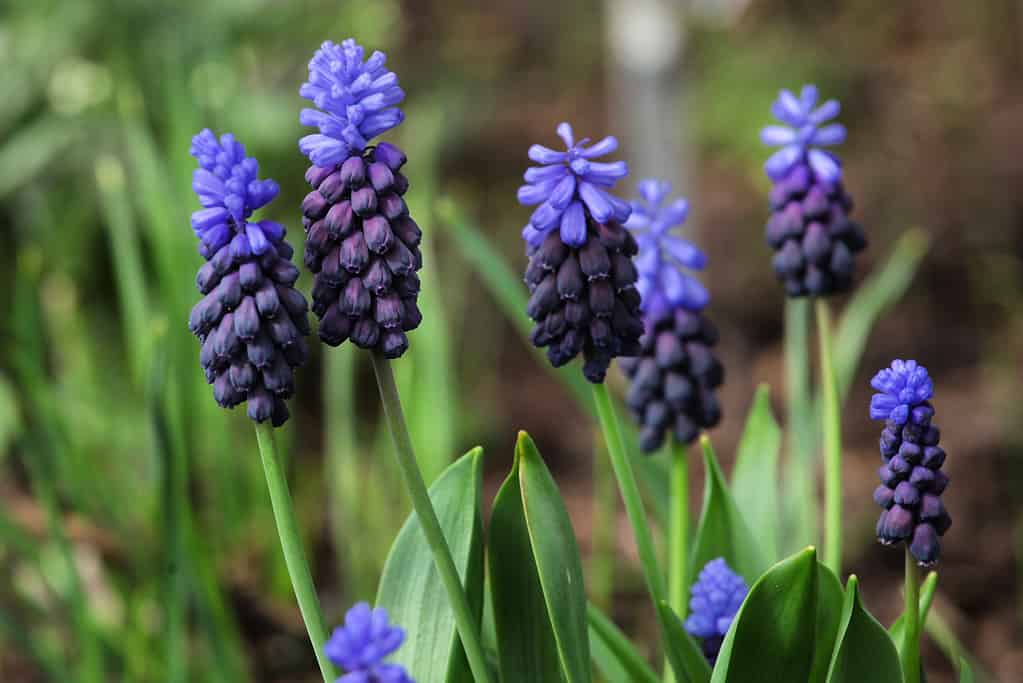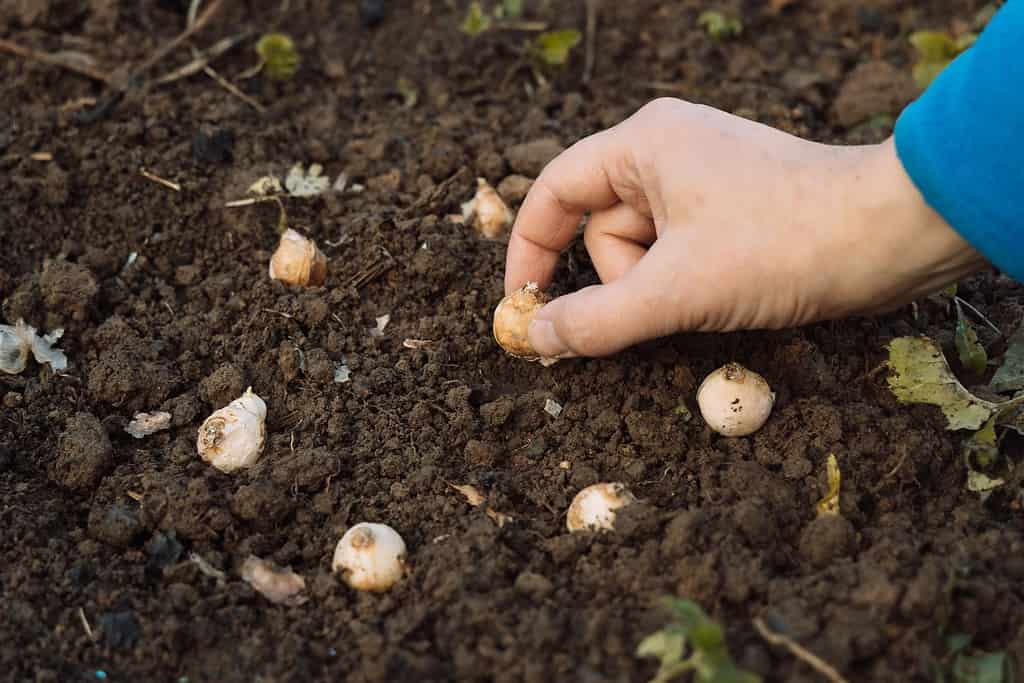Muscari bulbs produce some of the most unique and attractive flowers that are commonly available to gardeners throughout the world. The bright closed-bell shape blooms earn the plant its nickname of grape hyacinth, a gorgeous (usually) purple plant that pops up early in the springtime. Muscari belong to the same family as hyacinth, but though they have “hyacinth” in their common name, they are not true hyacinths, but rather a cousin plant.
Making excellent early blooming plants, cutting flowers, pollinator attractors, and much more, the stunning grape hyacinth is an excellent choice for anyone looking for an early spring touch of brightness in the garden space or indoor plants.

Muscari or grape hyacinth in full bloom
©Pavel Filatov/Shutterstock.com
| Botanical name | Muscari armeniacum |
| Popular varieties | Armenian grape hyacinth (Muscari armeniacum), Muscari armeniacum ‘Peppermint’, Muscari armeniacum ‘Blue Spike’, Muscari armeniacum ‘Siberian Tiger’, Muscari armeniacum ‘Touch of Snow’, Compact grape hyacinth (Muscari botryoides), Muscari botryoides ‘Album’, Muscari botryoides ‘Superstar,’Broad-leaved grape hyacinth (Muscari latifolium), Muscari latifolium ‘Grape Ice’, Common grape hyacinth (Muscari neglectum), Muscari neglectum ‘Baby’s breath’, Muscari neglectum ‘Valerie Finnis’, Tassel hyacinth (Muscari comosum/Leopoldia comosa), Muscari comosum/Leopoldia comosa ‘Monstrosum’, Muscari comosum/Leopoldia comosa ‘Plumosum’, Aucher Eloy grape hyacinth (Muscari aucheri), Muscari aucheri ‘White Magic’, Muscari aucheri ‘Ocean Magic’, Azure grape hyacinth (Pseudomuscari asureum/Muscari azureum) |
| Light needs | Sun to nearly full shade |
| Water needs | Moist but not over-saturated soil |
| Soil needs | Amended soil, ideally with compost |
| USDA Hardiness Zones | 3 to 9 |
| Beginner friendly? | Yes |
| Special care notes | They must not live in soggy soil, as this will lead to root rot and plant ruin. |
What Are Grape Hyacinth or Muscari Bulbs?

Muscari are often used in ornamental gardens and cutting gardens alike.
©Lyudmila Mikhailovskaya/Shutterstock.com
According to the University of Wisconsin-Madison, the muscari bulb, or grape hyacinth is a mid-spring bloomer that’s a perennial bulb belonging to the Liliaceae family in the asparagus Asparagaceae subfamily. Native to southeastern Europe, the plant is not a true hyacinth, though closely related. Meaning “musk,” the name comes from the Greek word in reference to the plant’s pleasant aroma. With bell-shaped blooms in cobalt blue, pale blue, purple, white, or even pale green, the flowers resemble clusters of grapes on a stalk, earning the plant its common name.
What Is a Bulb?

Muscari bulbs are often planted in pots, even like this overcrowded pot.
©Olga Mazo/Shutterstock.com
Often, flower bulbs are confused with a number of other types of plant sources. Typically, folks refer to bulbs as plants that grow from fleshy storage structures planted underground. Many of the commonly thought of bulb plants, however, aren’t bulbs at all.
Five types of bulbs exist:
- True bulbs examples: tulips, daffodils, hyacinths, muscari, alliums
- Corm examples: crocus, gladiolus, autumn crocus, tuberous begonias
- Tuber examples: caladiums, anemones, potatoes
- Tuberous root examples: begonias, dahlias, airplane plant, asparagus
- Rhizome examples: lily of the valley, canna lilies, bearded iris, ginger
- Fleshy root examples: peonies, daylilies, radishes, carrots
What Are Muscari Bulbs Used For?
Early flowering of muscari bulbs means these deliciously scented blooms are perfect for a number of things. They help bee gardens, for one, as they provide much needed early spring food for pollinators. They remain in bloom for long periods, often for a full month, making them an excellent choice particularly for cooler climates where other flowers may take longer to bloom. They are favored as flower bed, border, and cutting garden plants. They also thrive in rock gardens.
Varieties or Types of Muscari

Different varieties may have different shades of purple, white, pink, blue, or even green.
©Alex Manders/Shutterstock.com
Grape hyacinths bloom around the same time as true hyacinths though specific varieties may have slight variations on this. Consider each species before choosing one for your own garden.
About 40 species and varieties of muscari exist, though many of these are not commonly available for gardeners to enjoy. There are many that have been naturalized to the United States or are otherwise ready for planting, however, often available at nurseries, online plant stores, and similar retailers. Some of the most commonly available varieties include:
- Amemenian grape hyacinth (Muscari armeniacum), naturalized in Europe in alpine meadows and rocky slopes on woodland edges
- Compact grape hyacinth (Muscari botryoides), a self-seeding variety preferred for potted plants to avoid invasive species behavior
- Broad-leaved grape hyacinth (Muscari latifolium), natural to montane vegetation zones (species specific forests), with broader leaves than other species of muscari
- Common grape hyacinth (Muscari neglectum), found mostly in warmer regions in Europe, sometimes self-seeding
- Tassel hyacinth (Leopoldia comosa, syn. Muscari comosum), native to the Mediterranean in rocky ground and farmlands
- Aucher-Eloy grape hyacinth (Muscari aucheri), found in humus-poor, alkaline or lime-rich soil in sunny locales
- Azure grape hyacinth (Pseudomuscari azureum, syn. Muscari azureum), found in humus-rich, non-stony soils
How to Care For Grape Hyacinth Bulbs

Grape hyacinth are typically purple or blue but may come in white, pink shades, and others.
©Iva Vagnerova/Shutterstock.com
Grape hyacinths have some fairly easy to manage care needs from flexible lighting needs to fairly straightforward watering needs.
Light Requirements
Thriving is easy for the grape hyacinth, as it requires anything from full sun to nearly full shade. Some protection from intense sun may be required in hotter climates.
Water
Watering your muscari plants is fairly straightforward: keep the sun moist but not soggy. This generally means checking the soil every day or every other day to ensure the plant doesn’t dry out between waterings in the warmer season, and less frequently during dormancy (cooler months and non-growing seasons).
Soil Conditions
To make your muscari happy, plant them in good quality, well-draining soil that has been amended. Many folks opt for either peat moss or compost to improve the soil quality and drainage.
Fertilizer
While fertilizer can help most plants, overly rich soil will encourage foliage rather than flowers in your muscari. Some compost for in-ground plantings may well be all they require, while container plants could do with light granular feedings of 5:10:5 fertilizer before blooming.
How to Propagate Grape Hyacinths

Propagation of the often prolific plant isn’t particularly challenging.
©S.O.E/Shutterstock.com
- Autumn or early spring are the best times to divide muscari plants, so plan to do this propagation then.
- If the soil is dry, water it first and let the plant absorb the water for a bit before dividing the bulbs.
- Sliding a trowel into the soil a few inches away from the foliage, dig up the clump and gently separate the roots of each plant. Gently lift and loosen the soil away as you work with the clump of bulbs.
- Crumble away the soil from the bulbs, identifying the healthiest roots, preserve these and divide them out to establish new clusters.
- Choosing the best medium or large bulbs from the clump, replant these as new, separate muscari in a wide, shallow trench. Place the bulbs 3 to 4 inches deep and enrich the soil around the plant. These new plants will take another year or two to flower. Maintain the smaller bulbs together for the most growth potential.
- Add bone meal or bulb fertilizer to the soil and backfill the planting site.
- Water lightly and compact the soil around the bulbs gently.
How to Force Grape Hyacinth Indoors
One of the reasons so many folks love grape hyacinths is that they may be grown indoors as potted plants or with hydroponic methods. They’re fairly easy to force in either situation, though hydroponics are easiest.
- Purchase a bulb forcing vase (an hourglass shaped vase) and fill to the mid-section with clean, purified water.
- Place pre-chilled bulb into the vase, with the roots down.
- Place the bulb in a warm spot with bright, indirect light.
- Maintain the water levels for the plant, just touching the bottom of the bulb.
- Change the water out every two weeks.
The photo featured at the top of this post is © Alex Manders/Shutterstock.com
Thank you for reading! Have some feedback for us? Contact the AZ Animals editorial team.







